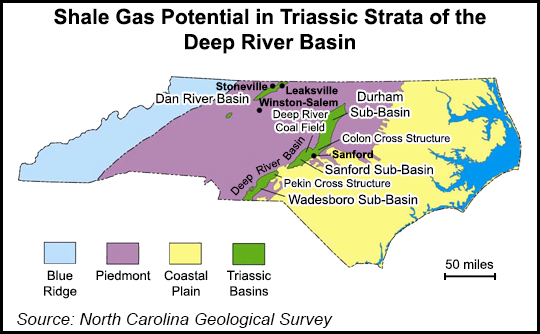North Carolina Bill Would End Forced Pooling
A bill filed last week in the North Carolina General Assembly would ban forced pooling and require landowner permission for oil and gas operations that disturb the surface of the land.

The bill, HB 586, was introduced on April 2 by state Rep. Bryan Holloway (R-King), whose district includes Stokes County and part of neighboring Rockingham County. It passed its first reading in the state House of Representatives on Monday and was subsequently referred to the House Environment Committee.
HB 586 would amend General Statute 113-393, which pertains to developing land as a drilling unit. Specifically, it inserts the language that the state’s Mining and Energy Commission (MEC) “shall not require the owner or lessor of subsurface oil or gas resources to integrate their interest with another owner’s interest or require extraction of that resource.”
The law also would stipulate that “if the owner of the surface of the land is not the owner or lessor of the subsurface oil or gas resources underlying the land, no surface operations or disturbances to the surface of the land shall occur without the written consent of the surface owner that approves the operations or disturbances.”
Last month, 120 rules governing oil and gas development, including one lifting a moratorium on hydraulic fracturing, took effect (see Shale Daily, March 17). The rules were created by the MEC, a division of the North Carolina Department of Environment and Natural Resources, and were outlined in the Energy Modernization Act, which Republican Gov. Pat McCrory signed into law last year (see Shale Daily, June 5, 2014).
Holloway’s district lies in the Deep River Basin, which the North Carolina Geological Survey said is a 150-mile half-graben that traverses most of the central part of the state in a southwest-to-northeast direction. The basin is divided into three sub-basins — from north to south, the Durham, Sanford and Wadesboro sub-basins — each of which include about 7,000 feet of Triassic strata.
In 2012, the U.S. Geological Survey (USGS) estimated that there was a 95% chance the Deep River Basin held 779 Bcf of natural gas and 35 million bbl of natural gas liquids (NGL), both of which were classified as undiscovered resources (see Shale Daily, June 21, 2012). USGS said there was a 50% chance the basin held 1.53 Tcf of gas and 75 million bbl of NGLs, and a 5% chance for 2.99 Tcf of gas and 158 million bbl of NGLs. The mean averages of the USGS estimates are 1.66 Tcf of gas and 83 million bbl of NGLs.
© 2024 Natural Gas Intelligence. All rights reserved.
ISSN © 2577-9877 | ISSN © 2158-8023 |
